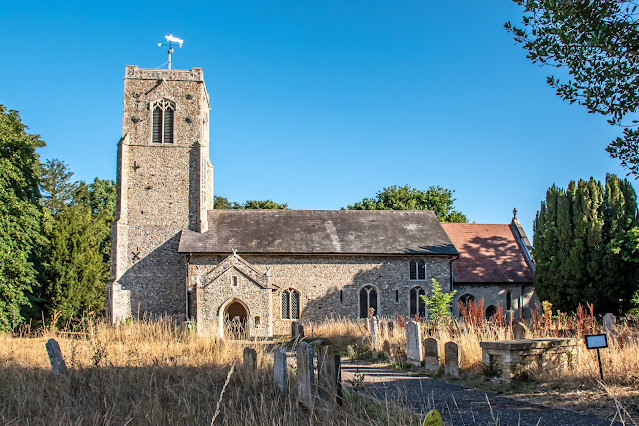The Wenhaston medieval Doom
There has been a church at Wenhaston since the Saxon period when it was owned by Blythburgh Priory. Most of the present building dates to the 14th and 15th centuries. The south door retains its medieval sanctuary knocker. Just inside the door is a beautifully carved wooden panel that must have formed part of a Jacobean pew. at the east end of the nave is a Jacobean pulpit with excellent carved details, including figures of angels on the book rest brackets. The chancel roof is decorated with carved bosses, and the choir stalls have particularly good carved bench ends. The east window has colourful Victorian glass, and on either side are 18th-century marble monuments to members of the Leman family. At the west end of the nave is a plain octagonal font, along with a royal coat of arms to George III and a charity board.
Few people find their way to Wenhaston by chance, located off the beaten track but just a few miles from the famous medieval church at Blythburgh. Those that make the effort to seek out Wenhaston are rewarded with one of the most remarkable medieval works of art in Britain - and this was exactly what I had come to see!
The Wenhaston Doom, a Last Judgement painting, is thought to have been made and erected by a monk from Blythburgh ca 1480 AD. It stood originally over the chancel arch but was probably covered in 1549 during the strongly Protestant reign of Edward VI.
The chancel became completely shut off from the nave by what was thought to be a whitewashed partition. In 1889, this partition was taken to pieces and placed in the churchyard ready to be demolished. Heavy rain in the night washed off some of the plaster, so that parts of the painting began to reappear. The whole partition was then cleaned and during the major restoration of 1892 it was re-erected in its present state over the entrance to the belfry. Later it was moved to its present position on the north wall where it partly covers the monument to the last member of the Leman line.
These paintings of the Last Judgement were quite common in mediaeval churches. The position of the Doom over the chancel arch is explained by the symbolism which pictured the nave as representing the Church Militant and the chancel as the Church Triumphant which are separated by the Judgement.
An uncommon feature is that the Rood was once attached to the painting, a sculptured figure of our Lord on the Cross, flanked by those of the Virgin and St John. The space can be seen where these figures once had been. A Rood or Rood cross, sometimes known as a triumphal cross, is a cross or crucifix, especially the large crucifix set above the entrance to the chancel of a medieval church. Alternatively, it is a large sculpture or painting of the crucifixion of Jesus.
Under the painting is a text, Elizabethan, from an unknown version of the English Bible, Romans 13, v 1-4 which reads:
"Let every soule submit him selfe unto the authorytye of the hygher powers for there is no power but of God the Powers that be are ordeyend of God, but they that rest or are againste the ordinaunce of God shall receyve to themselves utter damnacion. For rulers are not fearefull to them that do good but to them that do evyll for he is the mynister of God."
Perhaps this was intended to reinforce the severe warnings of the Act of Uniformity and to discourage any form of dissent?
Seated on a rainbow, the Divine Judge holds out His hands showing the wounds. a scroll nearby reads Venite benedicti (Come ye blessed). The Virgin Mary and John the Baptist in camel hair are supplicating for mankind. The second scroll near the moon reads Discedite mal-editicte, (Depart ye cursed).
At the left of the Cross is St Peter in cope and triple Papal tiara holding the key to the gate of heaven. He receives four of the saved - a King, a Queen, a Bishop, and a Cardinal.
Left of that group are the Heavenly (castellated) mansions; with an angel admitting a soul at each gate.
The fish's head and swine's snout on the far right represent the Jaws of Hell. A demon is blowing a ram's horn while figures in attitudes of despair are encircled by red hot chains while they are prodded into the chasm. The Seven Deadly Sins are represented and one, Lust (?) is seen carrying a female figure upside down. Five of the dead are rising from their graves to meet their Judge.










Comments